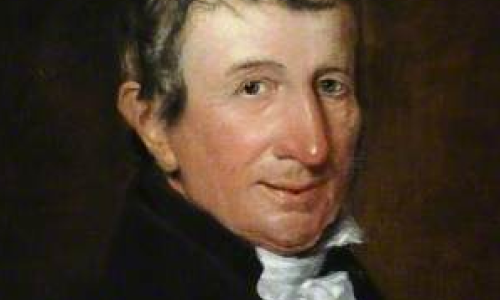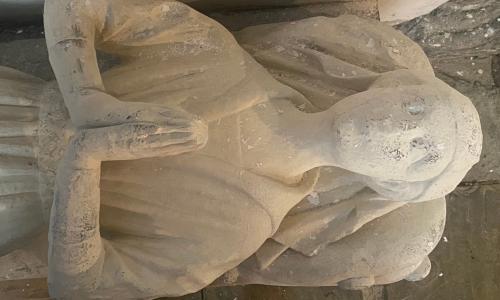Heraldry – using a language of symbols on shields to identify people and families – developed in the Middle Ages to identify armoured knights in battle. However, it could also be used by the Church to tell its stories through simple images.
Holy Trinity (now Hull Minster) lost much of its mediæval religious art in 1548, in an act of iconoclasm (image-destruction) under the radical Protestant young king Edward VI. Those images that survived were often difficult to reach, such as the paintings very high up on the vaults of the Crossing (under the tower). Heraldic-style symbols on shields are used to tell the Passion story. They probably date from 1510s-1520s, just before the Reformation. The Crown of Thorns is the central motif on each corner of the vault.
If you stand under the crossing, look up – using binoculars or a zoom lens on a camera – the scheme runs like this:
NE Corner
- A pot and 3 dice – used by the guards gambling for Jesus’s clothes.
- A bag with ‘30’ written on it – Judas’s 30 pieces of silver.
- The Crown of Thorns.
- Jesus’s tunic, for which the guards were playing dice.
- The midday sun.
NW Corner
- A cockerel – refers to Peter denying he knew Jesus three times before cock-crow.
- The lance, and the vinegar-soaked sponge on a stick offered during the Crucifixion.
- The Crown of Thorns.
- The column of the Flagellation.
- The eclipse of the sun when Jesus dies.
SW Corner
- A pair of pliers and a hammer: the pliers are usually shown to put the Crown of Thorns in place, and the hammer to nail Jesus to the Cross.
- The ladder – used to get up on the Cross.
- The Crown of Thorns.
- The title board at the head of the Cross: INRI (Iesus Nazarenus, Rex Iudaeorum), ‘Jesus of Nazareth, King of the Jews’.
- The 5 Wounds of Christ: hands and feet with nail-holes, and the spear-pierced heart with flame coming out of the top. A few years after this vault was painted, this emblem was used as the banner of the Pilgrimage of Grace, the Catholic rebellion against the suppression of the religious houses. This involved some of the local gentry, under the leadership of Robert Aske, one of the Askes of Aughton (near Selby).
SE Corner
- Crossed scourges, used in the flagellation.
- Cross raguly vert – The Cross depicted as the Tree of Life or Tree of Paradise, identified as the same tree whose fruit Adam and Eve ate.
- The Crown of Thorns.
- The three nails of the Crucifixion.
- The Crown of Thorns again.
Around the central boss, there are also roundels containing Stars of David and the letters of the Christogram in Greek: IHS XPS – abbreviations for ΙΗΣΟΥΣ ΧΡΙΣΤΟΣ – Jesus Christ.
For a 14C depiction of all the instruments of the Passion, which includes many of those shown here, see James Le Palmer's encyclopaedia All Good Things, c 1360-70, in the British Library.




